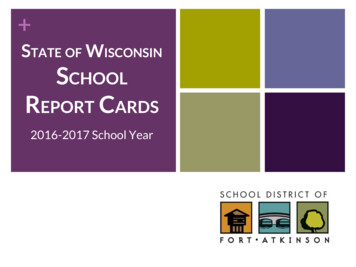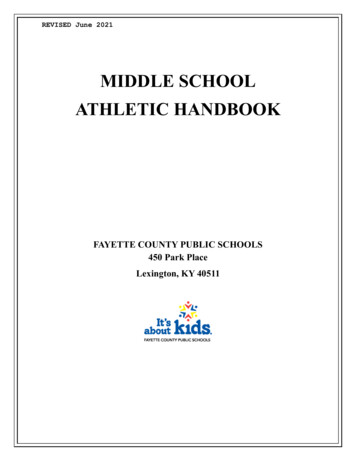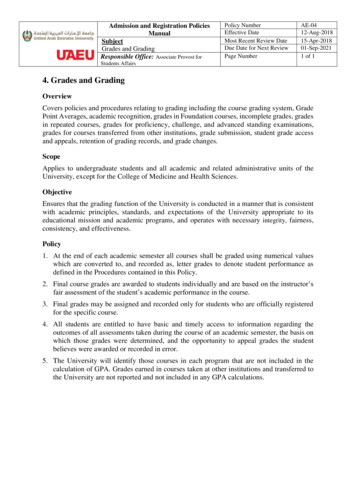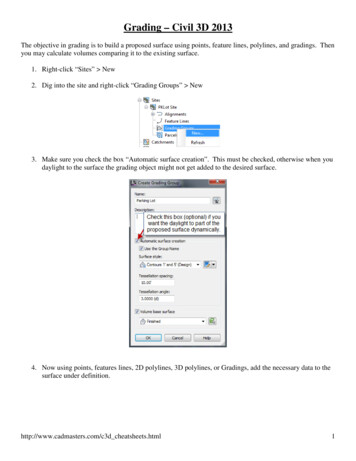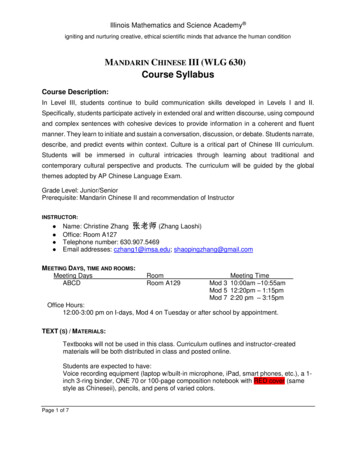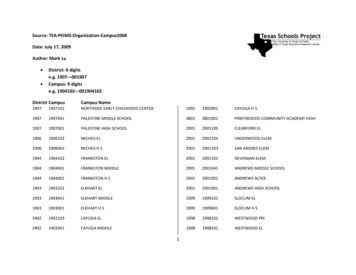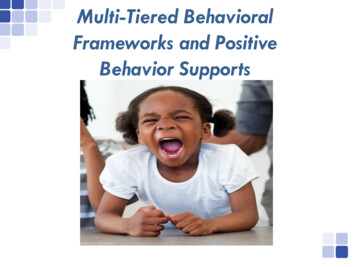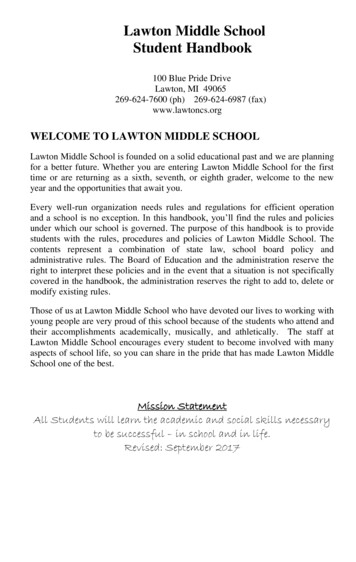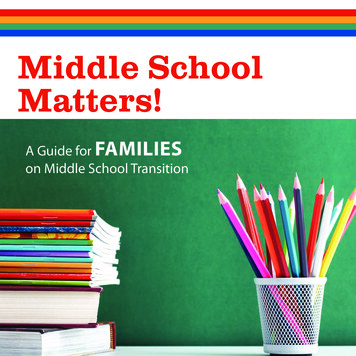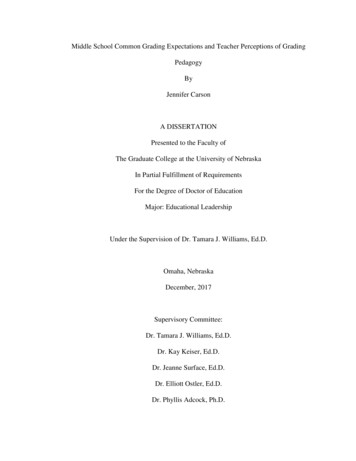
Transcription
Middle School Common Grading Expectations and Teacher Perceptions of GradingPedagogyByJennifer CarsonA DISSERTATIONPresented to the Faculty ofThe Graduate College at the University of NebraskaIn Partial Fulfillment of RequirementsFor the Degree of Doctor of EducationMajor: Educational LeadershipUnder the Supervision of Dr. Tamara J. Williams, Ed.D.Omaha, NebraskaDecember, 2017Supervisory Committee:Dr. Tamara J. Williams, Ed.D.Dr. Kay Keiser, Ed.D.Dr. Jeanne Surface, Ed.D.Dr. Elliott Ostler, Ed.D.Dr. Phyllis Adcock, Ph.D.
AbstractMiddle School Common Grading Expectations and Teacher Perceptions of GradingPedagogyJennifer Carson, Ed.D.University of Nebraska, 2017.Advisor: Dr. Tamara J. Williams, Ed.D.Grades in schools can be subjective in nature. Yet, grading remains a key piece in theAmerican education system. Beliefs around grading practices are deeply held and canvary from teacher to teacher. This study aims to explore how teachers arrive at their owngrading practices and to analyze teachers’ perceptions of implementing common gradingexpectations at one middle school in the Midwest. The implementation was grounded inresearch surrounding ethical change leadership. In year two of implementation, certifiedstaff responded to a survey of Likert scale and open-ended questions providing feedbackon implementing common grading expectations. The medians of responses wereanalyzed and compared to subgroups of grade level taught, core teachers, exploratoryteachers, other certificated staff, years of experience, content area, leadership experience,and experience teaching in more than one district. Then the open-ended qualitativeresponses were used to explain or justify the quantitative data. Overall findings indicatedno significant differences in perceptions of the subgroups. However, qualitative datashowed concerns with retakes and how authentic conversations and relationships are atthe core of effective change in schools. Though this study is not intended to be replicatedacross other schools, it may serve as a learning opportunity when considering a changeinitiative in grading practices.
AcknowledgementsI would like to thank my committee for your professional knowledge andfeedback along the way. Feeling comfortable asking questions and seeking yourguidance was a big help. Dr. Williams, this would not have been possible without you.You knew when to help and when to let me figure it out on my own. The weekend texts,emails, and phone calls were greatly appreciated. You provided a perfect balance ofpushing me to think, laughter, sarcasm, and expertise in the process.To my other colleagues along the way, you all proved it takes a village. Dr. DarinKelberlau, thank you for allowing me to continue my research through a job change.More importantly, thank you for being there on one of my most frustrating days. Youdropped everything on a Saturday afternoon to come help me for a few hours with yourstatistical expertise. For that, I am grateful. For all my MPS colleagues that offeredwords of encouragement and gave their time to my research, thank you for being part ofthe journey.Finally, there are no words to express my gratitude to my biggest supporter, TJ.Thank you for always backing me through my educational and professional pursuits. Theextra work and burdens you take on to allow me to reach my goals is nothing short ofamazing. This research is a reflection of both of our time and work. You made me laughand offered “suggestions” when I needed it most. To my kids Zander, Maclin, Kinzie,and Tegan, thank you for sacrificing many weekends without me to allow me to work. Iam excited to finally get back to normal family weekends.
Table of ContentsChapter One: Introduction . . 1Causes of Grading Variation 2Conceptual Framework 9Research Questions 13Definitions of Terms .13Limitations .16Delimitations .17Assumptions .17Significance of the Study .17Chapter Two: Research Literature Review 20Why Similarity is Important .20Grading Practices .27Zeros .28Grade inflation .29Non-achievement Factors Included in Grades .30Expand Assessment Options .32Homework .34Retakes .36
Grades as Rewards and Punishments .37Minimum Grade .38Initiatives Involve Change .39Evidence of Change .48Process of Initiating Change in Grading Expectations at the Research Site .52Chapter Three: Methodology and Design .56Study Design .56Population .57Instrumentation .57Data Collection .58Research Questions 59Data Analysis .60Chapter Four: Results 63Research Question #1 64Research Question #2 67Research Question #3 74Chapter Five: Conclusions 95Conclusions 95
Recommendations for Further Research .100Summary .101References 103Appendix .111
List of Multimedia ObjectsFigure 1: Michael Fullan’s (2004) Framework for Leadership .9Table 4.1 Overview of Median Frequencies by Teacher Type (Core, Exploratory, andOther) on Perceptions of Implementation Fidelity 67Table 4.2 Kruskal-Wallis by Teacher Type (Core, Exploratory, and Other) on Perceptionsof Implementation Fidelity 68Table 4.3 Overview of Median Frequencies by Grade Level on Perceptions ofImplementation Fidelity 69Table 4.4 Kruskal-Wallis by Grade Level on Perceptions of Implementation Fidelity 69Table 4.5 Overview of Median Frequencies by Years of Experience on Perceptions ofImplementation Fidelity 70Table 4.6 Kruskal-Wallis by Years of Experience on Perceptions of ImplementationFidelity 70Table 4.7 Overview of Median Frequencies by Years of Content on Perceptions ofImplementation Fidelity 71Table 4.8 Kruskal-Wallis by Content on Perceptions of Implementation Fidelity .71Table 4.9 Mann-Whitney Test Comparing Teachers Who Have District LeadershipExperience and Teachers Who Do Not Have District Leadership Experience onPerceptions of Implementation Fidelity 72
Table 4.10 Mann-Whitney Test Comparing Teachers Who Have Worked in OtherDistricts and Teachers Who Have Not Worked in Other Districts on Perceptionsof Implementation Fidelity .73Table 4.11 Overview of Median Frequencies by Teacher Type (Core, Exploratory, andOther) on Perceptions of Common Grading Expectations .75Table 4.12 Kruskal-Wallis by Teacher Type (Core, Exploratory, and Other) onPerceptions of Common Grading Expectations 76Table 4.13 Overview of Median Frequencies by Grade Level on Perceptions of CommonGrading Expectations 78Table 4.14 Kruskal-Wallis by Grade Level on Perceptions of Common GradingExpectations .79Table 4.15 Overview of Median Frequencies by Years of Experience on Perceptions ofCommon Grading Expectations 81Table 4.16 Kruskal-Wallis by Years of Experience on Perceptions of Common GradingExpectations .82Table 4.17 Overview of Median Frequencies by Content on Perceptions of CommonGrading Expectations 84Table 4.18 Kruskal-Wallis by Content on Perceptions of Common GradingExpectations .85
Table 4.19 Mann-Whitney Test Comparing Teachers Who Have Held District LeadershipPositions and Those Who Have Not on Perceptions of Common GradingExpectations .87Table 4.20 Mann-Whitney Test Comparing Teachers Who Have Worked In OtherDistricts and Those Who Have Not on Perceptions of Common GradingExpectations .89
1Chapter 1: IntroductionInterpreting a grade is like interpreting an abstract piece of art. A grade may bedisplayed as a percentage such as 95%. Or it may be displayed as a letter, such as A, B,C, D, or F, to represent some given percentage breakdown. Either way, it is left to beinterpreted by the viewer. Each person that views it sees what is important to him andtakes away whatever he chooses. One viewer may look and see every detail, analyze theway in which it was produced, and internalize the way it makes him feel. The nextviewer may instead give it a glance, decide it is not individually important, and find noemotional tie. Grades are the art that are left to interpretation.Grades are defined as a compilation of marks from multiple assignments andassessments that lead to a final judgement about students’ achievement. Grades are ateacher’s numeric or alpha evaluation of a student’s demonstration of knowledge and areused to communicate a variety of information. Just as an artist chooses the medium andcolor scheme, teachers are left to make a professional judgment regarding what will beincluded in a grade. When individual teachers are making decisions specific to eachclassroom, students' grades can encompass many sub-categories. The problem is thatwhen teachers try to report so many factors in a grade, they generally end up achievingnone of them very well (Guskey, 2004).Though grades can be subjective in nature, grading remains a key piece in ourAmerican education system. In fact, Lynn Olson (1995) observed that grades are “one ofthe most sacred traditions in American education.The truth is that grades have acquiredan almost cult-like importance in American schools” (p. 24). Educators rely on grades to
2help make key decisions about students. Grades hold value within schools as they are oneof the factors used to determine a student’s promotion, athletic eligibility, need foradditional support, and qualification for graduation. Outside the K-12 education system,colleges, the armed forces, employers, and scholarship-funders rely on grades to makedecisions about students that can open or close doors to their futures (Feldman, 2014).The importance of grades and the implications of utilizing grades holds value inthe United States K-12 education system. After exploring possible causes of gradingvariation, the literature review will investigate why similarity is important as well as thepros and cons of different grading practices used in schools today. The research onsimilarity, grading practices, implementing change initiatives, evidence of change, andFullan’s framework of ethical change leadership provides the structures for implementingthe common grading expectations change initiative at the research site.Causes of Grading VariationAccording to Wiliam (2016), in the United States, inconsistencies in classroomexpectations far outweigh inconsistent expectations at the building level. When lookingat a building as a whole, most times individuals can agree on the big rocks surroundinggrading practices. For example, all staff may agree grades need to represent studentdemonstration of knowledge. However, grading variation occurs based on how thestatement is interpreted or put into practice in the classroom. It is dependent onindividual teacher’s beliefs and experiences. This causes variation from classroom toclassroom. One teacher may believe “student demonstration of knowledge” consists ofgrades showing knowledge acquisition at specific times in a student’s learning. If a
3student earns a failing grade on an assignment, it tells a story about the student’sknowledge at that particular point in time and should be set in stone. On the other hand,the teacher next door may believe “student demonstration of knowledge” has no timeframe and allows multiple redo opportunities to demonstrate a higher level ofunderstanding with the grade being replaced with each redo attempt. Both teachersbelieve they are meeting the overarching goal of using grades to represent studentdemonstration of knowledge but are providing unequal opportunities for how studentsreach the end goal of a final grade. Due to the conflict from vision to implementation, itgenerally does not matter which school a student attends but it does matter whichclassroom a student is in (Wiliam, 2016).Another cause of variation stems from the belief that teachers need a healthy doseof independence. For leaders, giving autonomy can be a double-edged sword. On onehand, Sieh (2016) agrees on the importance for leaders to grant teachers autonomy.Fullan (2006) acknowledges educators appreciate getting to use their own judgment, toexercise discretion, and to determine the conditions of their own work in classrooms andschools. The positive side of promoting autonomy is it provides a sense ofprofessionalism. Fullan (2006) believes leaders should communicate the importance ofautonomy and then step back to allow teachers to run their classroom as they choose.Teachers create their own guidelines and expectations according to their own beliefs aslong as they fall under the general rules and policies.However, if leaders are providing autonomy, one study’s findings do not supportteachers feeling the autonomy. Sparks (2015) reports teachers feel they have lessautonomy in 2012 than they did in 2003. Veteran teachers with more than 10 years of
4experience showed the biggest sense of loss of control (Sparks, 2015). This may solelybe due to trends in education over the last several decades where veteran teachers haveexperienced various levels of autonomy over time. As schools have become morestructured with policies and accountability, it has forced a lessened sense of autonomy.On the negative side, when teachers feel deprived of independence, they lacksufficient understanding of and rationale for the vision and goal given by leaders. Thelack of understanding creates a silent resistance to share the same vision. Teachers oftenthen avoid voicing their opinions in hopes of continuing on with their own goals. Thismay contribute to job dissatisfaction and frustration, making the consistency gap evenwider (Griffiths & Portelli, 2015). With a variety of educational training programs, yearsof experience, content specialties, student needs, and leadership expectations, swayingtoo far to one side of autonomy creates varying grading practices and disruption to ashared vision.Another contributing factor to inconsistencies is comfort. Teachers with a fixedmindset might become comfortably numb and therefore lack continuous growth. Theirjob is, and has always been, to impart their knowledge (Dweck, 2006). They have stayedstatus quo for so many years because the surrounding systems have gone untouched. Forstatus quo schools, Schneider, Feldman, and French (2016) found “Each system hascontinued on, not because it represents the best we can do, but because it’s all that mostof us have ever known” (p. 65). While it seems impossible to stop learning and changing,it is the resistance to being challenged and the threat to long-established beliefs beingdisturbed that holds teachers and schools back (Griffiths & Portelli, 2015). Goodteachers continue learning with students and look to grow professionally. This includes
5keeping up with current research on grading practices and standards. When teachers getcomfortable with grading practices and refuse to change with the times, there are varyingdegrees of expectations with multiple levels of inconsistencies.However, the level of comfort felt by teachers is a direct result of the leadershipstyle. A transformational leader will seek to take others out of their comfort zone toencourage continuous learning. To push others out of their comfort zones, leaderschallenge ideas, ask hard, uncomfortable, uninviting questions, and refuse to accept theway things have always been done (Griffiths & Portelli, 2015). On the other hand, aleader who lives in the comfort zone may allow others to do the same. This can inhibit aschool from progressing forward since the leader is modeling a stagnant state of mindwith no growth mindset.Inconsistencies in implementing change can also be tied back to the leadership ofa school or district based on how initiatives are presented to stakeholders. Initiatives maybe implemented too quickly without all stakeholders understanding the change. Quicklearners will excel and thrive on the consistent grading practices while others willstruggle to learn the expectations. Thus, it is important for leaders to direct their attentionon one main focus that will have the greatest sustainable impact on improving academicachievement for students (Fullan & Quinn, 2016). It is important to clearly communicatethe main focus while acknowledging it may not have been a priority for previous leaders.If a leader focuses on consistent, equitable grading practices, the change will be slow andsteady but eventually the varying practices will converge to one common goal .higherstudent achievement.
6Fullan (2006) recommends constantly come back to the one focus until the newsystems become the new continuity. Create parameters that all stakeholders understandand work towards without taking away all autonomy. Those parameters should includeinput and collaboration. If rules are arbitrary or issued for the sake of asserting authority,the process will result in chaos (Griffiths & Portelli, 2015). Teachers need to understandthe content first, then the process. The content is what teachers will change and theevidence to support the change. The process is the how, including small steps,accountability, and support (Wiliam, 2016). The goal is to create consistency and sharedresponsibility, without pushing too hard or too fast and losing people along the wayVariation is also caused by teachers’ perceptions of unfair grading done to them.Teaching is a unique profession where teachers spend at least sixteen years as theconsumer before becoming the expert. Living on the other side of the teacher's desk forso many years, the experiences teachers have as students have an influence on who theybecome when they are the teacher. If teachers in training have obtained grades based onfactors other than academic achievement, they will have a difficult time acceptingtheoretical principles that do not match with their personal experience (Allen, 2005).Teachers "typically reflect back on what they experienced as students and use strategiesthat they perceived to be fair, reasonable, and equitable.Teachers do what was done tothem" (Guskey, 2004, p. 31).Also, many times teachers' preconceptions and expectations conflict with grades(Alm & Colnerud, 2015). A teacher may have had a sibling in the past that did notperform well. If the younger sibling is then in the class, the teacher may have apreconceived notion that he will not perform well either. As the student puts forth great
7effort and does not perform well, the student may perceive it as a reflection of what theteacher felt about the older sibling. The younger student can see this as unfair. When theyounger sibling goes into the teaching profession, he may use effort and participation ingrading as he found he was treated unfairly and wants to make a change. This teacher isnow grading on grounds that do not reflect student knowledge simply due to how he wastreated in school.Though past experiences weigh heavily when making grading decisions, teachers’own belief systems tend to weigh more. Friedman (1998) concluded that teachers tend tofind a way to have their grading policy reflect their own deeply held beliefs (notnecessarily knowledge) about how students should be graded, even if building or districtlevel policies exist. When individual teacher beliefs regarding grading are implemented,accuracy and validity of each grade can be argued. As Allen (2005) has found, itfrequently happens within the same school building that teachers hold very differentviews about the purpose of grades. The problem is compounded when teachers fail tocommunicate with their colleagues about their grading practices and each classroom isoperating with different expectations.If teachers and leaders communicate grading philosophy and practices, it ispossible to have the purpose of grades move beyond numerical computations and allowfor teacher judgment of proficiency (O'Connor, 2008). Communication can lead tocollaboration and a shared vision. Teachers who put individual beliefs aside have someshared, accurate meaning of what grades represent (Allen, 2005). Switching to asystematic method of grading may contribute to a collegial responsibility for every
8decision in the education system. A systematic approach holds every teacher andadministrator accountable to the same standards.O’Connor (2016) agrees that grading is complicated, subjective, emotional, andseems to have become inescapable in schools. However, the excessive time and energyplaced on grading is not necessary. O’Connor (2016) has found grading is not essentialfor learning. When much value is placed on the grade itself, learning may be lost intranslation. Grades have become an expectation within schools without necessarilyfinding a clear, consistent connection to student learning. This conflict forces educatorsto make a distinction between the importance of learning versus the importance ofgrading. The interpretation of these two topics leads to variation based on individuals’experiences. When grading practices are dependent on so many variables tied directlyback to human emotion and beliefs, finding common ground is complicated.Ultimately, according to Fullan (2006), the key is to reduce bad variation byincreasing consistency. The process of changing a system by implementing commongrading expectations to create consistency ties directly back to the main focus ofincreasing student achievement. How teachers perceive the change and perceive thelasting impact on their own pedagogy will have future implications for all students.Therefore, the purpose of this study is to explore how teachers arrive at their own gradingpractices and analyze teachers’ perceptions of implementing common gradingexpectations.
9Conceptual FrameworkThe conceptual framework to support this study is Fullan’s (2004) work onchange leadership. He identifies five components that work cohesively to bring aboutpositive change. The five components of moral purpose, understanding change, buildingrelationships, creating and sharing knowledge, and creating coherence were thefoundation for implementing common grading practices at the research site. There is alsoa set of personal characteristics a leader should possess in order to support the fiveprevious components. Leaders display energy, enthusiasm, and hope. When leaders liveand breathe the five components while also possessing the three characteristic traits, theycan draw in other members to generate long-term internal and external commitments.Fullan (2004) emphasizes when all these systems work together, the outcomes tend to bemore positive and the bad outcomes are reduced or minimized (see fig. 1).Figure 1: Michael Fullan’s (2004) Framework for Leadership
10The first component of moral purpose can be demonstrated in a variety of ways.Authentic leaders who have gained the trust of employees make moral decisions thatbenefit the larger group. Leaders create strategies to bring the moral purpose to life andmotivate others to pursue the same vision (Fullan, 2004). Though moral purpose isfocused on positivity, living the moral purpose also causes conflict. The vision and goalscan conflict with interests or purposes of other groups. Starratt (2007) believes eachhuman being is born with an internal moral agenda that cannot be negotiated or handedover to someone else. Therefore, the goal in creating a moral purpose is to align thevision with the motivators that already intrinsically live within each individual.Connecting purpose with others creates cooperative groups that thrive and move toward acommon goal. Fullan (2007) reminds leaders that “although moral purpose is natural, itwill flourish only if leaders cultivate it” (p. 25).When leaders combine moral purpose with a thorough understanding of change, ittends to lead to a deeper moral purpose. In leading others through change, we have tounlock what has previously been accepted, form new ideas, and then lock those new ideasinto place. However, leaders should use caution in being innovative. If leaders areconstantly implementing new initiatives, others can feel overwhelmed or lack focus onone task at a time. It is a fine balance between facing resistance head-on andoverwhelming others to the point that it destroys the climate and culture of the building.Understanding change also includes appreciating bumps along the way, also known as animplementation dip (Fullan, 2007). Leaders should not expect immediate results. In fact,it is more likely to anticipate a slide backwards before seeing forward progress. This dipcan be seen as a natural consequence of change and evidence that change is occurring
11(otherwise data would remain status quo). Being comfortable experiencing a dipdemonstrates the leader is able to stay focused on the long-term goal and let go ofnegative consequences that come with leading change.Allowing failed attempts to be part of the process also helps build relationshipswith stakeholders. Building positive relationships seems to be the one key component ofsuccessful change leadership. The “fake it ‘til you make it” philosophy is no longereffective in getting results (Fullan, 2007). Relationships are extremely powerful increating a shared vision and internal motivation. This power can be used for good or tomove an organization backwards. When the leader is an equal member in a positivecommunity, the organization will move forward. However, when there is a strong senseof community and the whole building is not part of it, members tend to reinforce andsupport ineffective practices (Fullan, 2007). This strains other relationships and takesaway from the shared moral purpose.The fourth component of creating and sharing knowledge ties directly back tofostering positive relationships. When schools have data without positive relationships, ittends to lead to misinterpreted and misused data (Fullan, 2007). Different groups willview the data from one perspective, the one that best fits their model of thinking.Therefore, new data will not lead to new ideas. People are more likely to change if theiremotions are tied to the change in behavior. The environment must be one of a sharedmoral purpose where people volunteer to share new ideas knowing they will be heard.Starratt (2007) reinforces the idea that new knowledge is often rejected because it goesagainst previously accepted ideas, philosophies, and frameworks. New knowledgeemerges from changing circumstances, new technology, and needs that arise. Without
12questioning existing beliefs and collective sharing of background knowledge,organizations will become stagnant.Finally, creating coherence will provide the structure for productive change. In anorganization where coherence is reached, the leader has let go of having full control andembraces ambiguity and the natural complexities of problem-solving processes. Whencoherence is lacking, the leader will often times resolve all the problems on his own. Orhe will delegate decision-making tasks to live in the comfort of having someone else takeresponsibility for decisions (Fullan, 2007). It does not build capacity nor does it tie backto creating a shared moral purpose. It also lessens the effect of peer pressure. Othersoften thrive from a healthy dose of peer pressure to meet expectations and be part offinding solutions. Ambiguity is messy and in that mess hides the creative solutionsstakeholders need to seek when the status quo is disrupted (Fullan, 2007).When Fullan’s five components of moral purpose, understanding change, buildingrelationships, creating and sharing knowledge, and creating coherence are supported byenergy, enthusiasm, and hope, the possibilities are endless. Unavoidable change willoccur but the “how” and “why” it occurs will differ based on the vision of the leader.When systems, structures, and a positive culture are laser-focused on the moral purpose,the organization is bound to move forward. According to Fullan (2007), “Information ison paper. Knowledge is in people” (p. 115). Maximizing people as the most importantresource, and supporting them along the way, will continuously build coherence andmaximize capacity building. Coherence and capacity building tie to the purpose of thisstudy as both can impact teachers’ perceptions of their own grading pedagogy.
13Research QuestionsThe central research question to be addressed is how do teachers formulate theirown grading practices and what are their perceptions of implementing common gradingexpectations? Within the study, the following sub-questions will be answered:1. What factors do teachers report impact their current grading philosophy and howdo the findings vary among subgroups including grade level taught, core teachers,exploratory teachers, other certificated staff, years of experience, content area,leadership experience, and experience teaching in more than one district?
Middle School Common Grading Expectations and Teacher Perceptions of Grading Pedagogy Jennifer Carson, Ed.D. University of Nebraska, 2017. Advisor: Dr. Tamara J. Williams, Ed.D. Grades in schools can be subjective in nature. Yet, grading remains a key piece in the American education system. Beliefs around grading practices are deeply held and can
